Building family culture is simply about doing things together. Shared experiences, shared interests, and repeated activities (traditions) are what stick in kids’ memories and make your family a fun place to belong. Exploring nature is together is a relatively easy, free activity that is accessible to all.
Even if the outdoors isn’t your thing, the fact that everything we see was intricately designed by our Creator makes it worth an investment of time and interest.
- The order, beauty, design and artistry in the natural world reveal God’s glory and goodness (Psalm 19).
- Every creature and every natural phenomenon does exactly what God has appointed it to do, is anxious for nothing, and receives all it needs from His hand (Psalm 145:15-16, 147:15-18).
- Entropy and decay and violence in nature reveal the devastating effects of the Curse (Genesis 3).
- The severity of nature and weather show us our own frailty and dependence on the Lord.
- The way that blessing comes out of death (mushrooms, anyone?) and value out of waste (compost and manure) demonstrate God’s providential working of good fruit out of evil circumstances.
- The way the seasons change, the sun rises, and the moon cycles provide us with tangible pictures of resurrection.
- The cycle of seedtime and harvest teaches us patience and that there is “a time for everything” (Ecclesiastes 3).
The world around us appeals to—and if we allow it, overwhelms—every one of our senses, showing that God is not concerned only with the soul but with the body, and that Goodness encompasses not only spiritual virtues but physical delights. And that is only scratching the surface!
Here is my advice on getting your family into nature, and nature into your family culture:
1. Get Outside. Obviously.
While nature books and documentaries have a place, they should be a minor supplement to your own personal experience with the outdoors. You don’t always have to plan special excursions; find ways to take your everyday life (meals, reading, homework, exercise, etc.) outside when possible.
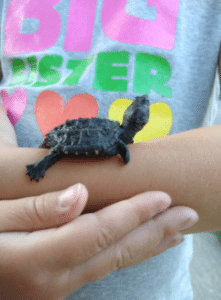
2. Slow down and look.
Take time to notice the sky while you’re driving. Spend time sitting and staring in your own back yard. What lives there besides you? On some of your walks, take out the ear buds, slow down the pace, bring all the kids, and notice the things you pass every day without a thought. If you can get to some woods or wetlands, walk slowly and look closely; you’ll find a lot to wonder at. Remember that “looking” includes all five senses!
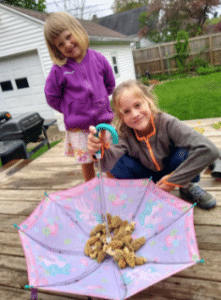
3. Keep it simple.
Enjoyment should come before study. You may one day want to identify every tree species in your neighborhood or sketch every local wildflower or sign up for guided walks at the nature center. But don’t begin with goals that can easily turn into checklists. Just look at the things around you, notice details, enjoy them, be surprised, wonder (when you look at something closely you will have questions—or if not, your kids will) and let curiosity drive your further study.
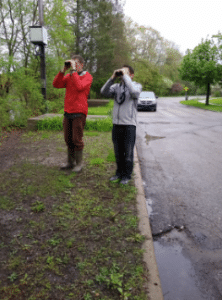
4. Choose tools that enhance your enjoyment.
Don’t let a field guide or an app become the nature activity. Identify things after you’ve first wondered what they are. Those pretty yellow flowers your kids pick every spring, that bird that always comes to eat the berries on your shrubs, that really crazy bug you found—these things are ripe for identification because you already appreciate them. Knowing their names and some interesting facts will help you enjoy them all the more.
Here are some tools that I recommend:
- Kaufman Field Guide to Nature of the Midwest if you are just getting started. It covers all kinds of things you will observe nature from insects to weeds to constellations, and will help you identify the most common species in our region.
- Peterson First Guides are small, inexpensive field guides that kids can learn to use without getting bogged down by the number of species and detail. Though you could find the information online, a beautiful, paper- and-ink field guide simplifies and enhances the experience of identifying.
- For identifying on the go, when you might not have your field guide handy, try out the Seek app by iNaturalist. This is a kid-friendly app that uses your phone’s camera and digital recognition technology to identify living organisms. (Parents may prefer the iNaturalist app which allows you to crowdsource identifications of your photos when the digital recognition is ambiguous). If you hope to do bird/wildlife watching or stargazing, a quality pair of
binoculars is a worthwhile investment.
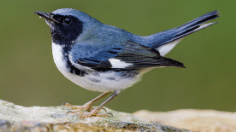
5. When your family enjoys an activity, make it happen regularly.
Maybe this is a weekly walk in some nearby woods (it’s fascinating to see the same patch of woods transform little by little as the seasons change), or an annual summer trip to a wilderness destination, or a natural collection (bugs or feathers or rocks) that you can continue adding to over years. These activities can help your kids mark the passing of time and make every season special. Here are some informal, seasonal activities my family looks forward to each year:
- Spring: admiring every tree that’s in flower as we drive or walk by, catching baby turtles and salamanders, seeing the orioles and warblers migrate through our neighborhood, picking up bird egg shells, pressing wild flowers, hunting for morels.
- Summer: catching fireflies, eating mulberries off the trees, watching a monarch caterpillar turn into a butterfly, picking wild blackberries, collecting cicada “skins” and hunting for the elusive live molting cicadas, hunting for petoskey stones at Lake Huron or agates at Lake Superior, and tumbling them in our rock tumbler, picking blueberries or cherries at a West Michigan farm, staying up late to catch meteor showers or comets when they occur.
- Fall: collecting and pressing leaves, eating wild apples, watching the squirrels go crazy, making a “Thanksgiving bouquet” of grasses and berries, picking the sticky seeds off of our fleeces and socks (we don’t look forward to that so much), stargazing (early darkness is an advantage).
- Winter: sliding on a frozen pond, eating icicles, looking for animal tracks and other signs of life when we’re out tromping, some years getting over to the great lakes to play on the cool ice structures that are like frozen waves, relishing every sign that spring is coming!
Happy exploring!
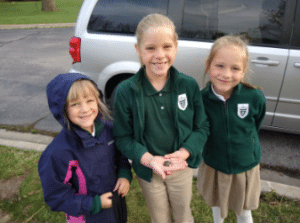
Want more ideas and motivation? Check out these resources:
- Brief suggestions from Charlotte Mason on experiencing the outdoors with children
- 30-minute Basecamp Live interview with Dr. Gordon Wilson on wonder in the natural world (do your kids have Nature Deficit Disorder?)
- The MSU planetarium staff made us a video explaining features of the summer sky after we had to cancel a field trip during the 2020 lockdown
- Free astronomy software allows you to view the night sky from any location at any point in time
- Apps for stargazing, apps for identifying rocks and geological features, and apps for probably anything else you want to explore in nature (just remember, the wonder is in the world, not the app!)
